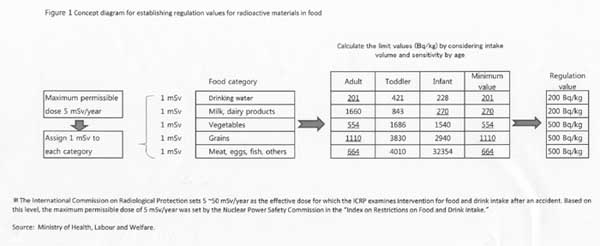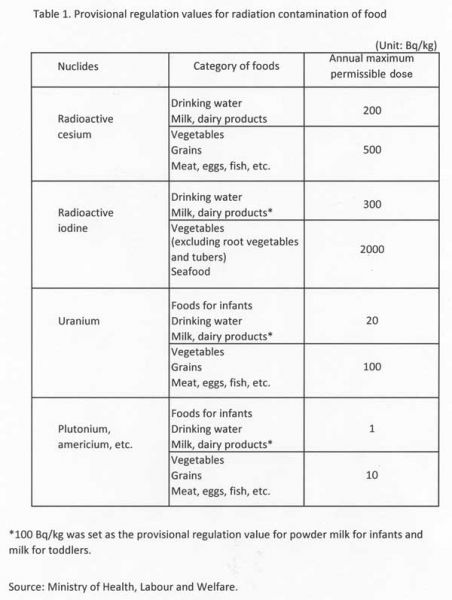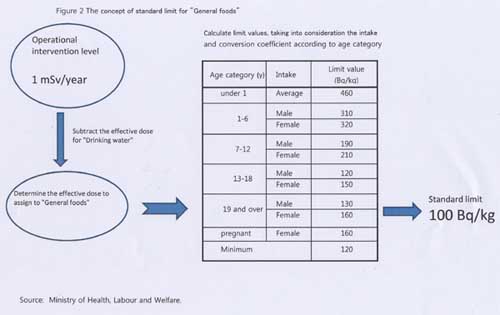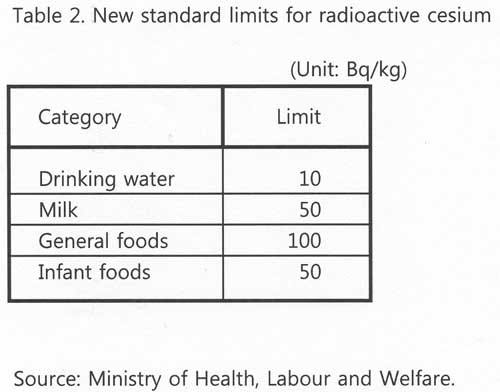Yoshihisa Godo,
Professor, Meiji Gakuin University, Japan
Introduction
On March 11, 2011, Japan experienced an unforgettable disaster at the Fukushima Nuclear Power Plant, which involved the wide-spread of radioactive materials. On March 17, 2011, the Ministry of Health, Labour and Welfare (MHLW) adopted provisional regulation values for radioactive materials in food with the aim of public health protection. However, these provisional regulation values were replaced by new values on April 1, 2012. Based on both the provisional and new regulation values, intensive monitoring has been conducted to prevent radiation contaminated foods from reaching the markets. This paper describes how the provisional and new regulation values for radioactive materials in food were calculated.
Regulations regarding radiation contamination in food before the Fukushima nuclear power plant accident
Before the Fukushima Nuclear Power Plant accident, the Japanese government did not have a framework to control the distribution of radiation contaminated foods. However, this does not mean that the government was unaware of the necessity of such a framework. On the contrary, the Nuclear Safety Commission, a council in the Cabinet Office, reported the necessity of introducing a framework to control the distribution of radiation contaminated foods in 1998. Japan experienced two major nuclear accidents between 1998 and 2011: (1) the critical accident in 1999 at Tokaimura and (2) the radiation leakage accident in 2007 at the Kashiwazaki Kariwa Nuclear Power Plant. It is unclear why the government neglected the proposal of the Nuclear Safety Commission despite these accidents. However, some researchers argue that the government had been afraid to cause more public anxiety about the safety of the nuclear power plants by publicly discussing the possibility of radiation contamination.
Provisional regulation values for radiation contamination in food.
On March 17, 2011, the MHLW announced provisional regulation values for radioactive materials in food (Table 1). Based on these regulation values, the Nuclear Emergency Response Headquarter, headed by the Prime Minister, instructed local governments to conduct intensive monitoring to prevent radiation contaminated food products from reaching the markets. The calculation procedure for the provisional regulation values is as follows.
The MHLW established four categories of radioactive contaminants: (1) “Radioactive cesium”, (2) “Radioactive iodine”, (3) “Uranium”, and (4) “Plutonium, americium, etc.” Based on Publication 63, which was published by the International Commission on Radiological Protection in 1993, the MHLW set the maximum permissible effective dose as 2 mSv/year for “Radioactive cesium” and 5 mSv/year for each of “Radioactive iodine”, “Uranium”, and “Plutonium, americium, etc.” Assuming that people continue to consume contaminated foods on a long-term basis, the MHLW derived regulatory values, based on the intakes for each food category, so that the permissible effective dose is not exceeded. The regulatory values were defined using the unit of Bq because Bq measures the intensity of radioactivity while mSv measures the effects of a radioactive material on the human body. The details of the procedure for calculating the provisional regulation values for radiation contamination in food are outlined below.
“Radioactive cesium”
The calculation procedure for determining the provisional regulation value for radioactive cesium is shown in Figure 1. The MHLW created provisional regulation values for “Radioactive cesium” according to five food categories: (1) “Drinking water”, (2) “Milk, dairy products”, (3) “Vegetables”, (4) “Grains”, and (5) “Meat, egg, fish, etc.” The MHLW allocated a dose of 5 mSv into these 5 categories evenly (i.e., 1 mSv per group; Figure 1, left). The MHLW then calculated the upper contamination limit according to age groups based on food consumption data from the MHLW’s National Health and Nutrition Survey (Figure 1, middle). After giving cautious considerations for safety, the MHLW set the provisional regulation values as 200 Bq/kg for “Drinking water” and “Milk, dairy products” and 500 Bq/kg for “Vegetables”, “Grains”, and “Meat, egg, fish, etc.” (Figure 1, right).

“Radioactive iodine”
Radioactive iodine accumulates in the thyroid. An effective dose of 5 mSv/year in the thyroid is equivalent to a dose of 50 mSv/year in the whole body. The MHLW set provisional regulation values for “Radioactive iodine” according to 3 food categories: (1) “Drinking water”, (2) “Milk, dairy products”, and (3) “Vegetables excluding root vegetables and tubers”. The maximum permissible dose was set at 11.3 mSv/year for each of the three categories with the consideration of ingesting radioactive iodine from foods other than those in the three categories mentioned above. Based on food consumption data from the MHLW’s National Health and Nutrition Survey, the MHLW set the provisional regulation values as 300 Bq/kg for “Drinking water” and “Milk, dairy products” and 2000 Bq/kg for “Vegetables excluding root vegetables and tubers”. In addition, the MHLW paid special attention to the treatment of foods for children because radioactive iodine caused childhood cancer during the Chernobyl disaster. For example, 100 Bq/kg was set as the provisional regulation value for powder and drinking milk for infants and children, respectively. Initially, the MHLW did not set provisional regulation value for seafood. However, after detecting a high contamination of radioactive iodine in silver anchovies on April 4, 2011, the MHLW set 2000 Bq/kg as the provisional regulation value for “Seafood”.
“Uranium”, and “Plutonium, americium, etc.”
The procedure for “Uranium” and “Plutonium, americium, etc.” was similar to the procedure used for “Radioactive cesium”. The MHLW adopted 5 food categories: (1) “Drinking water”, (2) “Milk, dairy products”, (3) “Vegetables”, (4) “Grains”, and (5) “Meat, egg, fish, etc.” and 1 mSv was allocated into each of the five categories. The provisional regulation values were then determined based on food consumption data from the MHLW’s National Health and Nutrition Survey. In addition, in order to protect the health of infants, the regulation value for “Infant foods” was set as the same value for “Drinking water” and “Milk, dairy products”, which was much lower than that for “Vegetables”, “Grains”, and “Meat, egg, fish, etc.”
Reports from the Food Safety Commission
When provisional regulation values were announced, mass media criticized the MHLW for lacking assessments regarding the effects of radiation contamination in foods on health. Therefore, the MHLW requested the Food Safety Commission, a commission in the Cabinet Office, to conduct these assessments. As a response to the request, the Food Safety Commission published “Urgent Summary of Radioactive Materials” on March 29, 2011. In this document, the MLHW’s provisional regulation values were not considered as inappropriate by the Food Safety Commission. However, it was asserted that further efforts for protecting consumer health are necessary.
The Food Safety Commission submitted an “Assessment Report” regarding the effects of radiation contamination in foods on health on October 27, 2011. Two points were addressed in this report. First, the maximum permissible effective dose from foods should be 100 mSv during a person’s lifetime. Second, children may have a higher susceptibility to radiation than adults.
New regulation values for radiation contamination in food
As a response to the “Assessment Report”, the MHLW requested the Pharmaceutical Affairs and Food Sanitation Council (PAFSC), a council within the MHLW, to establish new regulation values for radionuclides in foods on October 31, 2011. The PAFSC recognized that provisional regulation values were considered to be safe and food safety was basically secured after several discussions. However, to achieve further food safety and consumer confidence, the PAFSC reduced the maximum permissible effective dose to 1 mSv/year, which roughly corresponds to 100 mSv/lifetime as mentioned in the “Assessment Report”1.
Radionuclides that have a half-life <1 year (i.e., radioactive iodine) were removed from the new regulation system. Uranium was also removed because its level (Table 1) at the nuclear power plant site was approximately similar to its level in the natural environment. Regulation limits were established only for radioactive cesium because it was assumed that the contribution of other radionuclides was about 12%.

The PAFSC established four food categories: (1) “Drinking water”, (2) “Infant foods”, (3) “Milk”, and (4) “General foods” for other foods. Unlike the provisional regulation limits, the PAFSC included “Vegetables”, “Grains”, and “Meat, egg, fish, etc.” into the same category as “General foods”. There were three reasons for this treatment. First, it can possibly minimize individual differences in eating habits (deviation from consumed foods). Second, this treatment enables regulations to be more intelligible to consumers. Third, this treatment is consistent with international views, such as those of the Codex Alimentarius Commission. In contrast, the PAFSC separated “Drinking water”, “Infant foods”, and “Milk” from “General foods” because water is essential for human life and children are more susceptible to radiation than adults according to the Food Safety Commission (children consume a lot of milk).
The details regarding the calculation of regulation values are described below. Initially, the PAFSC established the effective dose as 0.1 mSv/year and the regulation value for “Drinking water” was 10 Bq/kg, which corresponded to the guidelines of the World Health Organization. The PAFSC then assigned an effective dose of 0.9 mSv/year to the “General foods” category by subtracting the effective dose for “Drinking water” (0.1 mSv/year) from the operational intervention level (1 mSv/year). The limit values for “General foods” were calculated by dividing 0.9 mSv/year by the intake and conversion coefficient according to age categories based on the assumption that 50% of the marketed foods were contaminated2 (Fig. 2). The lowest value between different age categories was 120 Bq/kg. The regulation value for “General foods” was established as 100 Bq/kg to ensure safety. For “Milk” and “Infant foods”, the regulation value was 50 Bq/kg, which was determined to be the level that was unaffected even if all marketed foods were contaminated.

On December 27, 2011, the PAFSC announced new regulation values for radiation contaminated foods (Table 2). After a period of preparation, the new regulation values became effective and the provisional values became invalid on April 1, 2012.

REFERENCES
1) Given that the average life expectancy of Japanese people is approximately 20 years, a radiation dose of 1 mSv/year is equivalent to about 100 mSv/lifetime.
2) The food self-sufficiency in Japan is nearly 40% in calorie base. The PAFSC assumes that foods produced at foreign countries are free from radiation contamination.
|
Date submitted: Setp. 30, 2014
Reviewed, edited and uploaded: Sept. 30, 2014
|


Regulation Values for Radioactive Materials in Food after the Fukushima Nuclear Power Plant Accident
Yoshihisa Godo,
Professor, Meiji Gakuin University, Japan
Introduction
On March 11, 2011, Japan experienced an unforgettable disaster at the Fukushima Nuclear Power Plant, which involved the wide-spread of radioactive materials. On March 17, 2011, the Ministry of Health, Labour and Welfare (MHLW) adopted provisional regulation values for radioactive materials in food with the aim of public health protection. However, these provisional regulation values were replaced by new values on April 1, 2012. Based on both the provisional and new regulation values, intensive monitoring has been conducted to prevent radiation contaminated foods from reaching the markets. This paper describes how the provisional and new regulation values for radioactive materials in food were calculated.
Regulations regarding radiation contamination in food before the Fukushima nuclear power plant accident
Before the Fukushima Nuclear Power Plant accident, the Japanese government did not have a framework to control the distribution of radiation contaminated foods. However, this does not mean that the government was unaware of the necessity of such a framework. On the contrary, the Nuclear Safety Commission, a council in the Cabinet Office, reported the necessity of introducing a framework to control the distribution of radiation contaminated foods in 1998. Japan experienced two major nuclear accidents between 1998 and 2011: (1) the critical accident in 1999 at Tokaimura and (2) the radiation leakage accident in 2007 at the Kashiwazaki Kariwa Nuclear Power Plant. It is unclear why the government neglected the proposal of the Nuclear Safety Commission despite these accidents. However, some researchers argue that the government had been afraid to cause more public anxiety about the safety of the nuclear power plants by publicly discussing the possibility of radiation contamination.
Provisional regulation values for radiation contamination in food.
On March 17, 2011, the MHLW announced provisional regulation values for radioactive materials in food (Table 1). Based on these regulation values, the Nuclear Emergency Response Headquarter, headed by the Prime Minister, instructed local governments to conduct intensive monitoring to prevent radiation contaminated food products from reaching the markets. The calculation procedure for the provisional regulation values is as follows.
The MHLW established four categories of radioactive contaminants: (1) “Radioactive cesium”, (2) “Radioactive iodine”, (3) “Uranium”, and (4) “Plutonium, americium, etc.” Based on Publication 63, which was published by the International Commission on Radiological Protection in 1993, the MHLW set the maximum permissible effective dose as 2 mSv/year for “Radioactive cesium” and 5 mSv/year for each of “Radioactive iodine”, “Uranium”, and “Plutonium, americium, etc.” Assuming that people continue to consume contaminated foods on a long-term basis, the MHLW derived regulatory values, based on the intakes for each food category, so that the permissible effective dose is not exceeded. The regulatory values were defined using the unit of Bq because Bq measures the intensity of radioactivity while mSv measures the effects of a radioactive material on the human body. The details of the procedure for calculating the provisional regulation values for radiation contamination in food are outlined below.
“Radioactive cesium”
The calculation procedure for determining the provisional regulation value for radioactive cesium is shown in Figure 1. The MHLW created provisional regulation values for “Radioactive cesium” according to five food categories: (1) “Drinking water”, (2) “Milk, dairy products”, (3) “Vegetables”, (4) “Grains”, and (5) “Meat, egg, fish, etc.” The MHLW allocated a dose of 5 mSv into these 5 categories evenly (i.e., 1 mSv per group; Figure 1, left). The MHLW then calculated the upper contamination limit according to age groups based on food consumption data from the MHLW’s National Health and Nutrition Survey (Figure 1, middle). After giving cautious considerations for safety, the MHLW set the provisional regulation values as 200 Bq/kg for “Drinking water” and “Milk, dairy products” and 500 Bq/kg for “Vegetables”, “Grains”, and “Meat, egg, fish, etc.” (Figure 1, right).
“Radioactive iodine”
Radioactive iodine accumulates in the thyroid. An effective dose of 5 mSv/year in the thyroid is equivalent to a dose of 50 mSv/year in the whole body. The MHLW set provisional regulation values for “Radioactive iodine” according to 3 food categories: (1) “Drinking water”, (2) “Milk, dairy products”, and (3) “Vegetables excluding root vegetables and tubers”. The maximum permissible dose was set at 11.3 mSv/year for each of the three categories with the consideration of ingesting radioactive iodine from foods other than those in the three categories mentioned above. Based on food consumption data from the MHLW’s National Health and Nutrition Survey, the MHLW set the provisional regulation values as 300 Bq/kg for “Drinking water” and “Milk, dairy products” and 2000 Bq/kg for “Vegetables excluding root vegetables and tubers”. In addition, the MHLW paid special attention to the treatment of foods for children because radioactive iodine caused childhood cancer during the Chernobyl disaster. For example, 100 Bq/kg was set as the provisional regulation value for powder and drinking milk for infants and children, respectively. Initially, the MHLW did not set provisional regulation value for seafood. However, after detecting a high contamination of radioactive iodine in silver anchovies on April 4, 2011, the MHLW set 2000 Bq/kg as the provisional regulation value for “Seafood”.
“Uranium”, and “Plutonium, americium, etc.”
The procedure for “Uranium” and “Plutonium, americium, etc.” was similar to the procedure used for “Radioactive cesium”. The MHLW adopted 5 food categories: (1) “Drinking water”, (2) “Milk, dairy products”, (3) “Vegetables”, (4) “Grains”, and (5) “Meat, egg, fish, etc.” and 1 mSv was allocated into each of the five categories. The provisional regulation values were then determined based on food consumption data from the MHLW’s National Health and Nutrition Survey. In addition, in order to protect the health of infants, the regulation value for “Infant foods” was set as the same value for “Drinking water” and “Milk, dairy products”, which was much lower than that for “Vegetables”, “Grains”, and “Meat, egg, fish, etc.”
Reports from the Food Safety Commission
When provisional regulation values were announced, mass media criticized the MHLW for lacking assessments regarding the effects of radiation contamination in foods on health. Therefore, the MHLW requested the Food Safety Commission, a commission in the Cabinet Office, to conduct these assessments. As a response to the request, the Food Safety Commission published “Urgent Summary of Radioactive Materials” on March 29, 2011. In this document, the MLHW’s provisional regulation values were not considered as inappropriate by the Food Safety Commission. However, it was asserted that further efforts for protecting consumer health are necessary.
The Food Safety Commission submitted an “Assessment Report” regarding the effects of radiation contamination in foods on health on October 27, 2011. Two points were addressed in this report. First, the maximum permissible effective dose from foods should be 100 mSv during a person’s lifetime. Second, children may have a higher susceptibility to radiation than adults.
New regulation values for radiation contamination in food
As a response to the “Assessment Report”, the MHLW requested the Pharmaceutical Affairs and Food Sanitation Council (PAFSC), a council within the MHLW, to establish new regulation values for radionuclides in foods on October 31, 2011. The PAFSC recognized that provisional regulation values were considered to be safe and food safety was basically secured after several discussions. However, to achieve further food safety and consumer confidence, the PAFSC reduced the maximum permissible effective dose to 1 mSv/year, which roughly corresponds to 100 mSv/lifetime as mentioned in the “Assessment Report”1.
Radionuclides that have a half-life <1 year (i.e., radioactive iodine) were removed from the new regulation system. Uranium was also removed because its level (Table 1) at the nuclear power plant site was approximately similar to its level in the natural environment. Regulation limits were established only for radioactive cesium because it was assumed that the contribution of other radionuclides was about 12%.
The PAFSC established four food categories: (1) “Drinking water”, (2) “Infant foods”, (3) “Milk”, and (4) “General foods” for other foods. Unlike the provisional regulation limits, the PAFSC included “Vegetables”, “Grains”, and “Meat, egg, fish, etc.” into the same category as “General foods”. There were three reasons for this treatment. First, it can possibly minimize individual differences in eating habits (deviation from consumed foods). Second, this treatment enables regulations to be more intelligible to consumers. Third, this treatment is consistent with international views, such as those of the Codex Alimentarius Commission. In contrast, the PAFSC separated “Drinking water”, “Infant foods”, and “Milk” from “General foods” because water is essential for human life and children are more susceptible to radiation than adults according to the Food Safety Commission (children consume a lot of milk).
The details regarding the calculation of regulation values are described below. Initially, the PAFSC established the effective dose as 0.1 mSv/year and the regulation value for “Drinking water” was 10 Bq/kg, which corresponded to the guidelines of the World Health Organization. The PAFSC then assigned an effective dose of 0.9 mSv/year to the “General foods” category by subtracting the effective dose for “Drinking water” (0.1 mSv/year) from the operational intervention level (1 mSv/year). The limit values for “General foods” were calculated by dividing 0.9 mSv/year by the intake and conversion coefficient according to age categories based on the assumption that 50% of the marketed foods were contaminated2 (Fig. 2). The lowest value between different age categories was 120 Bq/kg. The regulation value for “General foods” was established as 100 Bq/kg to ensure safety. For “Milk” and “Infant foods”, the regulation value was 50 Bq/kg, which was determined to be the level that was unaffected even if all marketed foods were contaminated.
On December 27, 2011, the PAFSC announced new regulation values for radiation contaminated foods (Table 2). After a period of preparation, the new regulation values became effective and the provisional values became invalid on April 1, 2012.
REFERENCES
1) Given that the average life expectancy of Japanese people is approximately 20 years, a radiation dose of 1 mSv/year is equivalent to about 100 mSv/lifetime.
2) The food self-sufficiency in Japan is nearly 40% in calorie base. The PAFSC assumes that foods produced at foreign countries are free from radiation contamination.
Date submitted: Setp. 30, 2014
Reviewed, edited and uploaded: Sept. 30, 2014